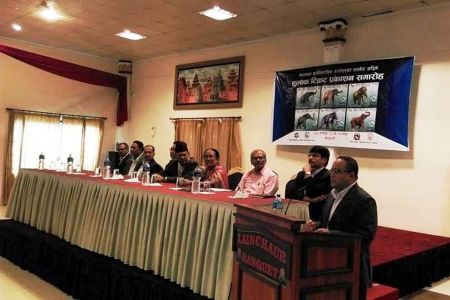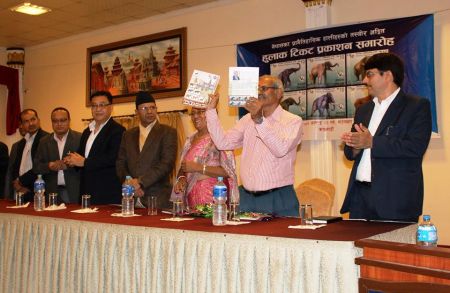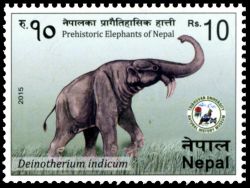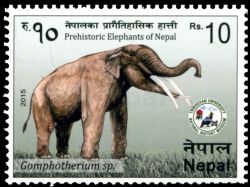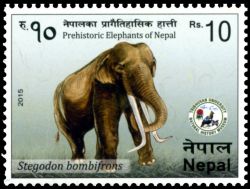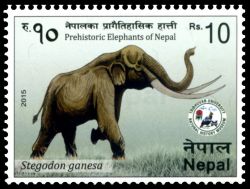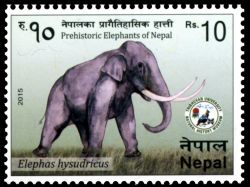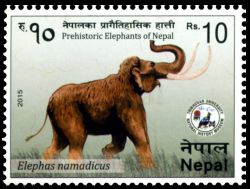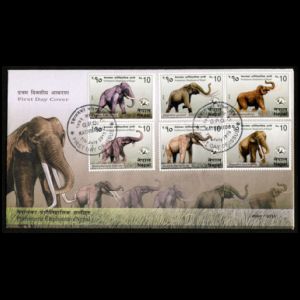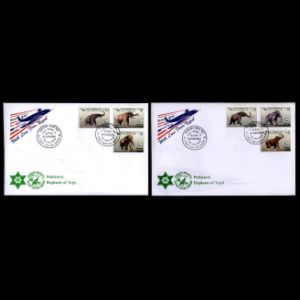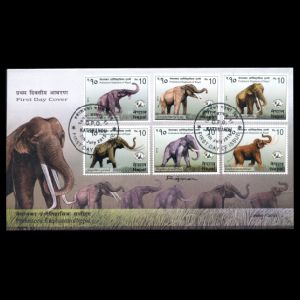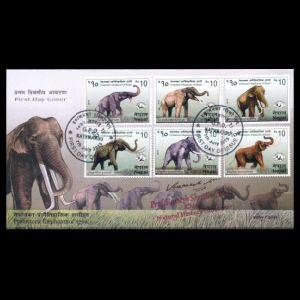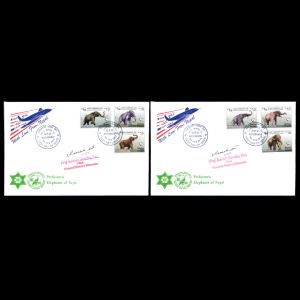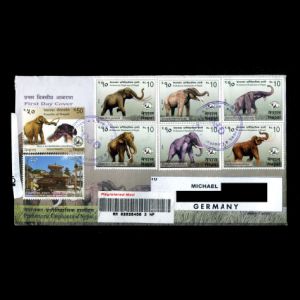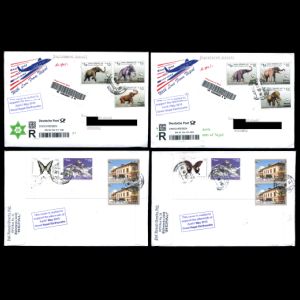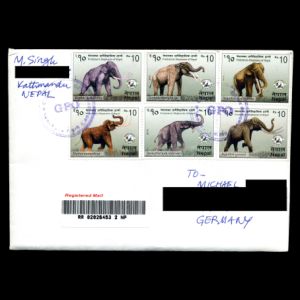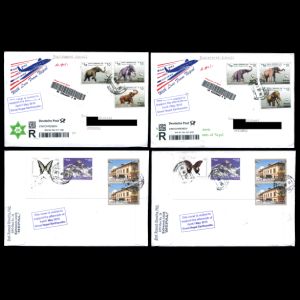Nepal 2015 "Prehistoric Elephants of Nepal"
| << previous page | back to index | next page >> |
| Issue Date | 07.07.2015 |
| ID | Michel: 1179-1184 ; Scott: 980-985; Stanley Gibbons: 1184-1189; Yvert et Tellier: 1138-1143 ; Category: pR |
| Design |
Illustrations: Mr. Rajman Man Maharjan, the artist
at the Natural History Museum of Nepal Stamps Design: Mr. Purna Kala Limbu Consultant: Dr. Ramesh Shrestha, Chief of Natural History Museum, Nepal |
| Stamps in set | 6 |
| Value |
Rs. 10.00 - Deinotherium indicum Rs. 10.00 - Gomphotherium sp. Rs. 10.00 - Stegodon bombifrons Rs. 10.00 - Stegodon ganesa Rs. 10.00 - Elephas hysudricus Rs. 10.00 - Elephas namadicus |
| Emission/Type | commemorative |
| Issue place | Kathmandu |
| Size (width x height) | 42.5 mm x 31.5 mm |
| Layout | 30 stamps per sheet |
| Products | FDC x 1 |
| Paper | Security Stamp paper UV dull with visible & invisible fibers & phosphorescent dots. |
| Perforation | 13 x 13.25 |
| Print Technique | Offset Lithography |
| Printed by | Joh Enschede Stamps B. V., The Netherlands |
| Quantity | 500.000 each stamp |
| Issuing Authority | His Majesty's Government of Nepal Postal Services Department |
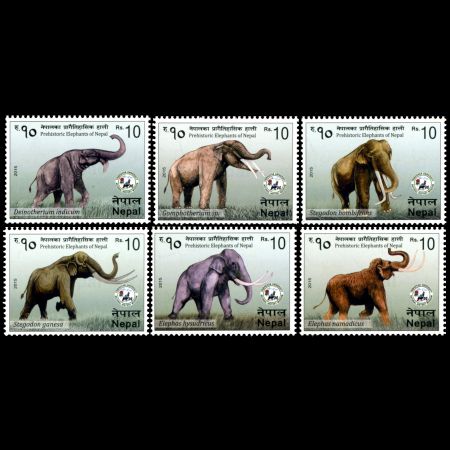
On July 7th, 2015, the Post Authority of Nepal in cooperation with the Natural History Museum of Nepal issued the second stamp set of prehistoric animals.
Distinguished from the set from 2013, this set is dedicated to one group of animals only: prehistoric elephants.
These stamps presentation took place on the same day in the Museum with present of special guests, including
- Prof. Dr. Ishwar Chandra Dutta, Chairman of Tribhuvan University Service Commission.
- Chairperson Dean Chirika Shova Tamrakar, Institute of Science & Technology, Tribhuvan University
- Drona Pokhrel, Director General of Postal Service Department
- Mr. Sunil Bahadur Malla Secretary of Ministry of Information and Communication
- Prof. Dr. Ramesh Shrestha, Chief, Natural History Museum, Swayambhu.
The text below is based on the information printed in the flyer attached to official FDC and the reverse side of commemorative covers issued by the Natural History Museum of Nepal, written by Dr. Ramesh Shrestha, Chief of the Natural History Museum.
The Proboscideans order encompasses the mammals with long muscular trunks. At the present time, there are only two Proboscideans species alive. One of them is the Asian elephant (Elephas maximus) found in mixed habitat zones in Sri Lanka, India, Nepal and parts of Southeast Asia.
The other one is the African elephant (Loxodonta africana) found in Sub–Saharan forests and grasslands.
The present Prehistoric elephants of Nepal stamps series contain six elephants, as described below.
Deinotherium indicum (Family: Deinotheriidae)
Deinotherium also known as a ‘terrible beast’ was a large prehistoric relative of modern–day elephants that appeared in Late/Middle Miocene and survived until Early Pleistocene. Deinotherium evolved from the smaller early Miocene Prodeinotherium. Its trunk was shorter and it had downward curving tusks attached to the lower jaw. Three species of Deinotherium giganteum in Europe, Deinotherium bozasi in Africa and Deinotherium indicum in India, Nepal and Pakistan are known. The molar tooth of Deinotherium was discovered at Babai River by Dr. Robert West & his team 1978, in west Nepal. This molar tooth is in the collection of Natural History Museum.
Gomphotherium (Family: Gomphotheriidae)
Gomphotherium is called welded beast, which evolved in the late Oligocene/early Miocene of North America from 13.650 to 3.6 MYBP living about 10 million years. The genus immigrated into Eurasia and Africa after a drop in sea level (probably during the Tortonian Epoch) allowed them to cross over. It survived into the Pliocene and its remains have been found in many countries including Nepal. These animals probably lived in swamps or near lakes using their tusks to dig or scrape up aquatic vegetation. Several fossils of Gomphotherium are reported from Babai River by Dr. Robert West and his team in 1978 and Surai Khola by Dongol in 1985 and again by Gudrin Corvinus in 1988 in Nepal.
Stegodon bombifrons (Family Stegodontiidae)
The Gable–toothed Elephant or Stegodon bombifrons is the initial stage of the true elephant family, or more correctly, the transition from Mastodon to Elephant. In Bardia National Park in Nepal, there is a population of Indian Elephants which, possibly due to inbreeding, exhibit many Stegodon like morphological features. Some dismiss these primitive features as recent mutations rather than atavisms. Gudrin Corvinus found the skull of this elephant at Rato Khola, in Nepal in 1988.
Stegodon ganesa (Synonym Stegodon insignis, family Stegodontiidae)
Stegodon, also known as roofed tooth elephant, is the genus of the sub family Stegodontinae. Although it was assigned to the family Elephantidae by some authors, but it has more comfortably been placed in Stegodontiidae due to its certain features which are more towards stegodons than true elephants. In some individuals the tusks were so close together that the trunk probably did not lie between them but instead draped over. The molars of Stegodon ganesa are reported from Kathmandu valley (Sharma & Singh, 1966 and Corvinus, 1988) and Babai Khola (West & Munthe, 1981).
Elephas hysudricus (Synonym: Hyselephas hysudricus, family Elephantidae)
Elephas hysudricus is an extinct elephant species and was described from fossil remains found in the Siwalik Hills. It lived during the Miocene and Pliocene epochs. The molar teeth of Elephas hysudricus has been reported from Kathmandu valley by Dongol in 1987.
Elephas namadicus (Family Elephantidae)
Elephas namadicus was a species of 2.1 metre–tall prehistoric elephant that ranged throughout Pleistocene Asia from India (where it was first discovered) to Japan where the indigenous Neolithic cultures hunted that particular subspecies for food. Elephas namadicus is a descendant of the Straight-tusked elephant. The molar teeth of Elephas namadicus was discovered from the alluvial deposits of Binai Khola near Pidari village at Dumkibas in Nawalparasi.
Related stamps
| "Fossils of Nepal" | "Natural History Museum of Nepal" | "Prehistoric mammals of Nepal" |
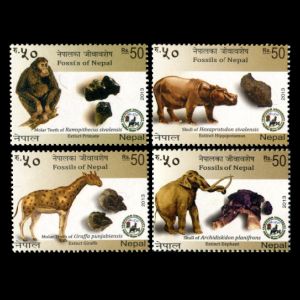 |
 |
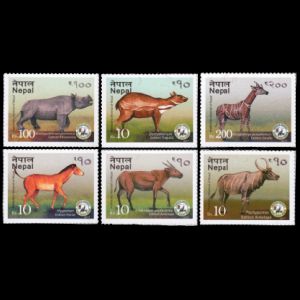 |
Products and associated philatelic items

|
 |
References
-
Technical details and short description of the stamps:
-
Description of prehistoric animals depicted on the stamps:
- Inside text of FDC
- Book "Prehistoric Mammals of Nepal", by Prof. Ramesh Shresta, published in 2015 in Nepal. ISBN: 978-9937-2-9672-4
Acknowledgements
- Many thanks to Dr. Peter Voice from Department of Geological and Environmental Sciences, Western Michigan University, for reviewing the draft page and his valuable comments.
- Many thanks to Mr. Shankar Shrestha and Dr. Ramesh Shrestha for their support.
| << previous page | back to index | next page >> |
